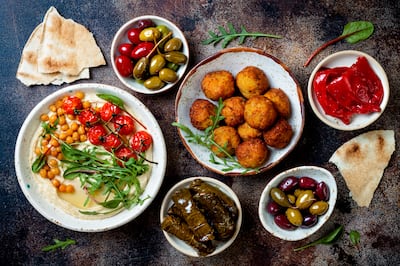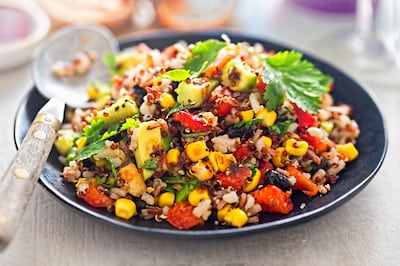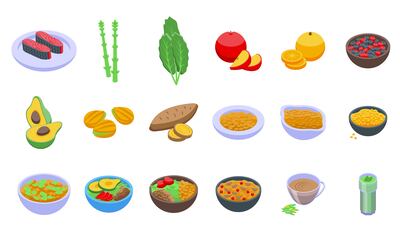American food writer Michael Pollan once recommended that we should not eat anything our great-grandmothers wouldn’t recognise as food. This pithy advice goes to the heart of the challenge of eating healthily for many people who have grown up on heavily processed western diets.
Interestingly, many traditional diets from across the world provide local populations with most of the nutrients required to keep healthy and well when leading active lives. “Humans evolved needing certain nutrients from the foods that were locally available and the traditional diets that worked are the ones that lasted,” says Sarah Keogh, dietician and lecturer in the master’s on applied culinary nutrition at the Technological University of Dublin.
What most traditional diets share is an emphasis on eating plenty of locally grown, seasonal fresh fruit and vegetables, grains and legumes combined with smaller amounts of high protein foods (fish, meat, cheese,) seasoned mainly with herbs and spices. “Many regional diets have different patterns of getting the same nutrients. And while cooking methods varied across regions, the prevalence of one-pot cooking helped ensure that nutrients weren’t lost,” says Keogh. Cooking meals from scratch in soups, stews and curries – and the absence of processed foods is also common to most traditional diets.
And while the Mediterranean diet has been studied the most, close scrutiny of other regional traditional diets reveals that many of them contain very similar health benefits – particularly regarding the reduced risk of cardiovascular disease.
READ MORE
Arguably, the traditional Irish diet (with lots of root vegetables, foraged berries and herbs and head-to-tail animal protein) was a reasonably healthy balanced diet – which was massively disrupted by the huge reliance on potatoes in the 19th century, but that’s a story for another day. Yet it’s interesting to note that in some parts of the world, historic ethnic cuisines are being revived to help people eat more healthily whilst also reclaiming their cultural heritage.
Here follows a short guide to regional diets from around the world with reference to the foods they include and scientific research into their health benefits.
Mediterranean diet
What is it? Probably the best-known of all regional diets, the Mediterranean diet is based on the foods traditionally eaten by people who live in countries bordering the Mediterranean Sea.
What foods does it include? The emphasis is on locally grown fruits, vegetables, nuts, pulses and herbs – think tomatoes, peppers, courgettes, aubergines, lettuce, spinach, peas, beans, apricots, pomegranates, walnuts, almonds, pine nuts, basil, oregano, thyme and extra virgin olive oils. The Mediterranean diet also includes grains (wheat, rice, corn) moderate amounts of fish and poultry, cheese and yogurt but very little red meat. A glass of wine with the main meal is optional, but little or no sweets, sugary drinks, processed foods and butter. Cooking styles vary from Greece to Italy to the South of France and Spain, but the use of fresh ingredients seasoned mainly with herbs rather than salt reigns supreme.

What are the health benefits? Several studies have found that the Mediterranean diet lowers the risk of cardiovascular disease due to the reduced amounts of saturated fats (from animal sources) in the diet which prevent the build-up of plaque in the arteries. It also helps to stabilise blood sugar levels due to the complex carbohydrates in wholegrains which promote slower digestion (and less sugary foods which would spike blood sugar levels) thus reducing the risk of Type 2 Diabetes. Studies have also found that the Mediterranean diet supports a healthy balance of gut microbiota. One recent study led by Professor Paul O’Toole from the APC Microbiome Institute at University College Cork found that staying on a Mediterranean diet for one year reduces frailty and improves cognitive function in older people.
Nordic or Scandinavian Diet
What is it? Similar to the Mediterranean diet in that it also focuses on locally-sourced foods – fruits, vegetables and wild seafood from Norway, Denmark, Sweden, Finland and Iceland. The main difference is that the Nordic diet uses canola oil rather than extra-virgin olive oil. Canola oil is made from crushed canola seeds which are a genetically modified form of rapeseed. Other vegetable oils (flaxseed and sunflower seed) are also used.
Most studies on the Nordic Diet have focused on how it promotes weight loss because of the absence of highly-processed foods and less saturated fats from animal protein
What foods does it include? Typical foods include oily fish (salmon, tuna, herring, mackerel), root vegetables (beets, turnips, carrots and onions), fruit (apples, pears, plums, lingonberries, cloudberries), whole grains (rye, barley and oats) and low-fat dairy (Skyr yogurt). Eggs and game meats such as venison (a good source of lean protein and lower in saturated fat compared to other red meats) are eaten in moderation. Processed meats, high salt and high sugar foods and beverages are avoided.

What are the health benefits? The Nordic diet has twice the amount of fibre and seafood and much less sugar than traditional Western diets. And while there are far fewer studies into the health benefits of the Nordic diet, experts agree that if followed carefully, it provides many of the health benefits of the Mediterranean Diet. Most studies on the Nordic Diet have focused on how it promotes weight loss because of the absence of highly-processed foods and less saturated fats from animal protein. However, one study from the University of Copenhagen in 2022 found that the Nordic Diet can lower blood sugar and cholesterol levels even without weight loss. The low-salt content of the Nordic Diet also helps reduce blood pressure.
Middle-Eastern diet
What is it? Lebanon, Israel, Turkey, Syria and Egypt are the countries we most associate with what is known as the Middle-Eastern diet. Meals are comprised of a collection of small hot and cold dishes served at the same time known as mezze.
What foods does it include? Vegetables (onions, aubergines, beetroot, squash, peppers, okra) fruits (lemons, pomegranates, dates, figs, watermelons), aromatic spices, fresh herbs, nuts, olive oil are central to Middle Eastern cuisine. Pulses such as chickpeas, grains such as bulgar and durum wheat and barley are other key elements while lamb and goat are prominent in the traditional meat dishes.

What are the health benefits? Traditional Middle Eastern cuisine is one of the healthiest diets in the world as most dishes incorporate lean proteins, healthy fats, vegetables, grains, spices, seeds and herbs into almost every dish. Serving several shared dishes can also help people eat less and more slowly giving a satisfied feeling without overeating.
In a study published in the Public Health and Nutrition journal in 2011, researchers from the Hebrew University of Jerusalem and the Technion – Israel Institute of Technology looked at the so-called biblical seven plant species (wheat, barley, grapes, figs, pomegranates, olive and date honey) and other indigenous foods from the Middle East. They concluded that all these foods are now recognized as healthy foods which when combined with the traditional Mediterranean diet, further improves the beneficial health effects of that diet.
Japanese and the Okinawa diet
What is it? The Japanese diet is the traditional cuisine from Japan which has been often cited as the healthiest in the world. The Okinawa diet is a derivative of the Japanese diet eaten by people from the Ryukyu Islands (Okinawa being the largest of these islands) south of Japan. Traditionally, the indigenous people of these islands had the highest life expectancy in the world.
The seaweeds, which are a key ingredient in many dishes, are rich in protein, minerals and salt
What foods does it include? The Japanese Diet includes lots of raw and cooked fish, seaweed, rice, soya beans (tofu), mushrooms, fruits, vegetables and spices. Pork is eaten in moderate amounts but other animal products (including dairy foods) are not part of the Japanese diet. Green tea is consumed regularly during meals. The Okinawa diet is based on similar ingredients to mainland Japan but in smaller portions. Small quantities of pork and fish are often served in a broth with a variety of vegetables and herbs. The purple-fleshed Okinawa sweet potato is the staple rather than rice and the indigenous bitter melon (goyain) regulates blood sugar.

What are the health benefits? Japanese food is nutrient dense and low in calories but can be high in sodium due to use of miso and soy sauce. The seaweeds, which are a key ingredient in many dishes, are rich in protein, minerals and salt. Traditionally, there is also a limited use of oils and fat. One 2016 study in the British Medical Journal, found that the Japanese diet high in grains and vegetables with moderate amounts of animal protein and soy (but minimal fruit and no dairy) reduced the risk of early death from heart disease and stroke. Japanese people historically have also low rates of obesity.
Latin American diet
What is it? It’s much trickier to identify the typical diet of an entire continent but as with other regional diets, locally grown foods are key ingredients in many of the dishes in Central and South American countries. The traditional cuisine of Aztecs, Incas, Mayans and other native Americans has been influenced over the centuries by the Spanish and Portugese colonizers and people whose roots are in continental Africa.

What foods does it include? Beans, corn, rice, squash, tomatoes, peppers, avocadoes and onions feature in many dishes of this region. Plantains (a less sugary variety of banana), yams, cassava and potatoes are sources of carbohydrates. Soups and stews with chicken, beef, pork or fish and egg dishes provide protein. Rice and beans are often served together. Cheese and milk and fermented milk drinks and yogurts are also part of the diet.
What are the health benefits? Like other regional diets, the traditional cuisine of South and Central American countries contained a nutritionally balanced diet for local populations. One-dish meals with plenty of vegetables, beans and limited amount of animal protein provided nourishing and non-fattening foods yet the diets of Latin America are no longer considered to be exemplary healthy diets. According to the Food and Agriculture Organization of the United Nations, obesity is the greatest nutritional threat in Latin America and the Caribbean while malnutrition impacts about 6 per cent of the population.
The Westernisation of the traditional diet (low in fruits, vegetables and wholegrains and high in salt, sugar-sweetened drinks and processed foods) has increased non-communicable diseases such as diabetes, cancer and heart disease. The Latin American Heritage Diet encourages people from Central and South America to improve their health by reclaiming their culinary history. The North American Oldways food and nutrition nonprofit organization focuses on improving public health through the promotion of heritage recipes and historic food cultures.
African diet
What is it? Traditional diets across the African continent relied on locally grown vegetables, herbs and spices which varied from one climatic region to another.

What foods does it include? Green and root vegetables, pulses, tubers like yams, cassava, yuca and sweet potatoes, beans of all kinds, lots of fruit, grains, nuts and spices. Popular wholegrains include barley, fonio, maize, millet, rice and sorghum. In traditional African diets, meat and fish were not the focus of the meal but instead used to enhance stews and soups. For example, jollof rice dishes are popular in West African countries and couscous dishes in North African countries.
[ Dead or alive? The doctor’s challengeOpens in new window ]
What are the health benefits? A study published in the Lancet Global Health in 2015 found that people in Mali, Chad, Senegal and Sierra Leone have healthier diets than their counterparts in the United States, the United Kingdom, Japan and Canada. This study confirms other research on how regional diets which are rich in fruit and vegetables have a lower risk of developing heart disease, stroke, obesity, Type 2 diabetes and cancer.
Similar to the Latin American Heritage Diet, the African Heritage Diet reclaims healthy food traditions of people with African roots.
Ayurvedic diet
What is it? The Ayurvedic diet originated in India and is part of wider medicinal practices and approaches that promotes the balance between body and mind. Food should be enjoyed and eaten calmly to improve digestion with the main meal eaten in the middle of the day.

What foods does it include? The Ayurvedic diet is vegetarian so meat is not included. Typical foods include soaked beans, legumes and grains, seasonal vegetables and fruits, nuts and seeds, olive and coconut oil, fermented foods such as yogurt and miso and teas. The Ayurvedic diet puts an emphasis on so-called cooling foods in the summer months and warming foods during the winter months. Alcohol is not recommended and individual diets and meal plans are worked out according to individual’s constitution.
What are the health benefits? Advocates of the Ayurvedic diet contend that when followed carefully, it improves digestion, decreases inflammation, improves fertility, helps with weight management and psychological wellbeing.


















